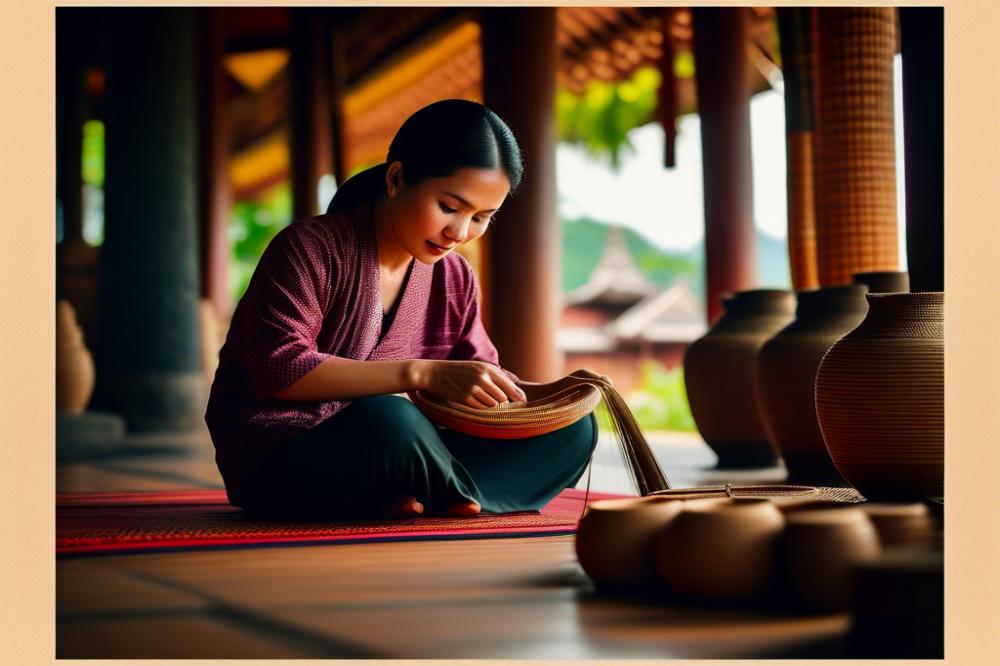Chiang Mai’s Traditional Handicraft Villages
Chiang Mai holds a special place in Thai culture. This city, known for its rich history, serves as a cultural center in northern Thailand. Many traditions thrive here, showcasing the country’s artistic diversity. Visitors are drawn to its festivals, temples, and, of course, its craftsmanship. The artistry of skilled artisans tells stories from ancient times, reflecting the heart and soul of local communities.
Handicrafts are a vital part of life in Chiang Mai. They represent not just skills but also local traditions passed down through generations. The craftsmanship seen in handmade products is a testament to the dedication of the local artisans. Visitors to this region often seek authentic souvenirs, and there’s no better place to find them than in the bustling markets and quiet workshops located in traditional villages.
Taking a tour of these villages offers a unique experience. Guests can witness traditional techniques in action, from weaving to pottery. Interacting with artisans may deepen understanding of their craft and culture. Holidays spent exploring these areas often transform into memorable adventures. Each visit reveals the authenticity of Chiang Mai’s cultural heritage, making it an enriching journey for all who participate.
Chiang Mai handicrafts

Chiang Mai is famous for its vibrant handicrafts, reflecting the region’s rich heritage. These artisan crafts are not just products; they embody the artistic expression of local traditions. Each piece tells a story, passing down skills from generation to generation. Visitors often seek out handmade products that serve as authentic souvenirs, connecting them to the local culture.
Various forms of crafts can be found throughout the area. Wooden carvings, intricate textiles, and silverware are among the most celebrated. Local artisans pour their hearts into creating items that represent their community’s identity. The skills involved often come from traditional techniques that have stood the test of time. These methods not only preserve artistic integrity but also promote sustainable practices.
Exploring the handicraft villages provides a glimpse into the daily lives of the craftsmen. Village tours allow guests to witness the creative process firsthand. Tourists may see artisans weaving beautiful fabrics or molding clay into exquisite pottery. This interaction enriches understanding and appreciation of the craftsmanship behind each item. Appreciating these art forms fosters respect for the cultural heritage of the region.
In Chiang Mai, the significance of handicrafts goes beyond beauty. They serve as vital links to historical customs, showcasing a way of life that honors traditions. The dedication seen in the creation of Thai handicrafts illustrates a profound connection between the makers and their craft. This bond forms a crucial part of shaping identity and community values within the villages.
Handmade crafts also play a role in the local economy. Many artisans rely on the sale of their products for livelihood. By purchasing these creations, visitors contribute to the sustainability of these traditional practices. The impact of supporting local artisans extends beyond transactions. It fosters a stronger sense of pride within the community, encouraging the continuation of these beautiful traditions.
The Artisan Craft Villages

Chiang Mai is home to several notable handicraft villages, each with its own special focus. These areas are where local artisans practice their crafts, keeping the local traditions alive. Tourists often visit these villages to see the artisans at work, and to learn about their skills.
Ban Tawai
Ban Tawai is known for outstanding wood carving. Skilled craftsmen create intricate designs that reflect Thai culture. Visitors can find furniture, decorative items, and even sculptures. Each piece showcases the craftsmanship that has been passed down through generations. Local artisans here are committed to preserving traditional techniques.
San Kamphaeng
This village is famous for its silk weaving. The colorful fabrics produced in San Kamphaeng are a major draw for tourists. Here, artisans use traditional methods to craft their silk products. Watching the weaving process gives insights into Thai culture and local heritage. Many people come for handmade products that are both beautiful and authentic souvenirs.
Huay Kaew
Huay Kaew’s pottery stands out for its distinctive style. Clay pots, vases, and bowls come to life through the hands of local artisans. The process of pottery making is fascinating to witness. Each item is carefully shaped and decorated, showcasing true craftsmanship. This village also emphasizes the importance of community in preserving these skills.
Chiang Mai’s Local Artisans
Local artisans play a crucial role in preserving craftsmanship that is part of Thailand’s cultural heritage. Their dedication to quality and tradition is evident in every piece they create. Supporting these artisans not only helps keep traditions alive but also fosters a sense of community. Visitors who engage with the artisans often appreciate the depth of knowledge behind the crafts.
Experiencing the Villages
Village tours offer a unique opportunity to engage with the artisans directly. Many tours allow guests to participate in workshops. Visitors can try their hand at pottery, weaving, or wood carving. These interactive experiences create lasting memories and an appreciation for the hard work behind each handmade product. Learning about traditional techniques makes the visit even more enriching.
Handmade Products and Authentic Souvenirs

Chiang Mai is famous for its artisan crafts. Visitors flock to the area to experience local traditions through various handmade products. Each item tells a story. From intricate wood carvings to beautiful textiles, every piece reflects the region’s cultural heritage.
Buying authentic souvenirs from local artisans makes a difference. It supports their livelihoods and helps to preserve traditional techniques. Tourists can feel good knowing that their purchases contribute to the community. When you buy directly from artisans, you often get a glimpse into their craftsmanship. This connection can enhance the value of the item beyond its price tag.
Numerous markets and shops play a vital role in promoting Thai handicrafts. The bustling Night Bazaar offers a vibrant atmosphere full of choices. Each stall showcases unique creations from skilled hands. In addition, village tours provide opportunities to meet the makers. Visitors can watch them at work and even try their hand at some crafts, which is a memorable experience.
Sustainable tourism has become increasingly important. More travelers are looking for ways to engage with local cultures while minimizing their impact. Supporting artisans aligns with this goal. When tourists favor handmade goods, they help fuel the local economy. This positive effect creates a cycle of growth that benefits the entire community.
Cultural Heritage and Local Traditions
The artisan crafts found in Chiang Mai are more than just decorative items; they tell stories of the region’s cultural heritage. Craftspeople often use traditional techniques passed down through generations. Each handmade product reflects the lore and history of the local traditions. Patterns and designs often feature elements inspired by nature, local beliefs, and historical events. Visitors quickly learn that these items are not merely souvenirs, but pieces of the community’s identity.
Reflection of Local Traditions
Local traditions play a vital role in shaping these crafts. Many artisans incorporate rituals and practices into their work. For example, some practices involve offering predictions or prayers during the crafting process. This connection to spirituality is evident in the final products, imbuing them with deeper meaning. Additionally, many artists attend village tours where they showcase their work and explain the significance behind each piece.
Festivals Celebrating Craftsmanship
Festivals in Chiang Mai are vibrant celebrations of craftsmanship. Events like the Chiang Mai handicrafts Fair draw large crowds eager to witness traditional arts. During these gatherings, artisans demonstrate their skills, allowing visitors to see craftsmanship in action. This not only fosters appreciation but also encourages the next generation to partake in these ancient practices. Attendees often leave with new insights about the importance of preserving these local traditions.
Artisans and Community Connection
Artisans form the backbone of Chiang Mai’s handicraft villages. Many have strong connections to their communities, passing on skills to their children. Stories abound of how the crafts shaped their lives, both personally and economically. When people purchase these items, they support local artisans and preserve their way of life. Those who create these treasures often express gratitude towards the community that uplifts and promotes their work.
Planning Your Visit
For tourists looking to explore Chiang Mai’s traditional handicraft villages, planning is key. A good starting point is to visit during the cooler months, from November to February. This period offers pleasant weather, making it easier to wander through various villages. Avoid the hot season to fully appreciate the outside atmosphere while learning about artisan crafts.
Researching local tours can enhance your experience. Several companies offer organized village tours that showcase the area’s cultural heritage. These tours often include visits to multiple villages, giving you a chance to see different types of craftsmanship. A quick online search or inquiries at tourist information centers can provide useful recommendations.
When you arrive, engaging with local artisans is a rewarding experience. Ask questions about their work and traditional techniques. Many artisans are thrilled to share stories about their craft and the processes involved. Take time to appreciate the skill that goes into each handmade product. This personal interaction not only enriches your understanding, but it also supports their livelihood.
Bring cash when shopping, as many villages may not accept cards. Local markets often feature authentic souvenirs from the craftsmen themselves. Purchasing directly from artisans ensures that your money supports the community. It also gives you meaningful items to take home, reflecting the local traditions.
In addition, don’t hesitate to try your hand at some crafts. Many villages offer workshops where tourists can practice basic techniques. Learning from skilled craftsmen can provide insight into the hard work behind Thai handicrafts. Participating in these activities creates lasting memories.
Lastly, remember to be respectful of the local culture. Each village has its customs and traditions. Understanding and appreciating these can greatly enhance your visit. You’ll find that the experience is much more fulfilling when you connect on a deeper level with the community.
Final Thoughts on Chiang Mai’s Handicraft Heritage
Chiang Mai’s artisan crafts play a vital role in attracting tourists. Visitors flock to these charming villages, eager to witness the artistry that defines the region. The intricate skills of local artisans reflect centuries of cultural heritage. Purchasing handmade items can support these creators and their families. This bond between craftsmanship and community is essential to the economy.
Experiencing the cultural richness of the villages is more than just shopping. Engaging with craftsmen offers insight into their traditions and methods. Walking through colorful markets or workshops, you can see how age-old techniques are preserved and passed down. Embracing these experiences helps keep the local traditions alive for future generations.
Support for these artisans is crucial. By choosing to buy handcrafted goods, tourists encourage sustainable practices. Each purchase tells a story of dedication and heritage. It is a chance for travelers to connect with the vibrant culture of Chiang Mai. Remember, every piece carries the unique touch of its maker.
In summary, visiting Chiang Mai’s handicraft villages provides a meaningful experience. The beauty of these artisan crafts lies in their history and skill. By appreciating and supporting local artisans, we all play a part in preserving the rich tapestry of this enchanting region.



